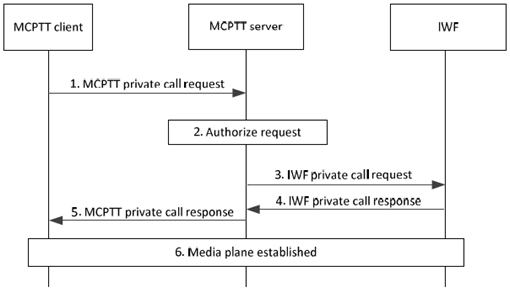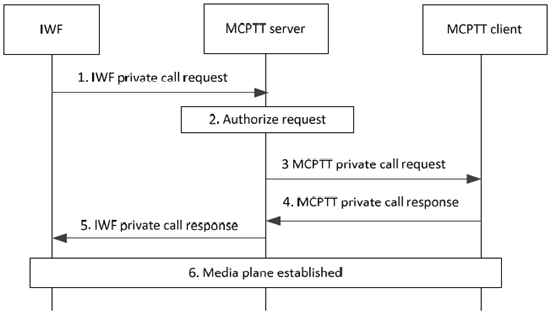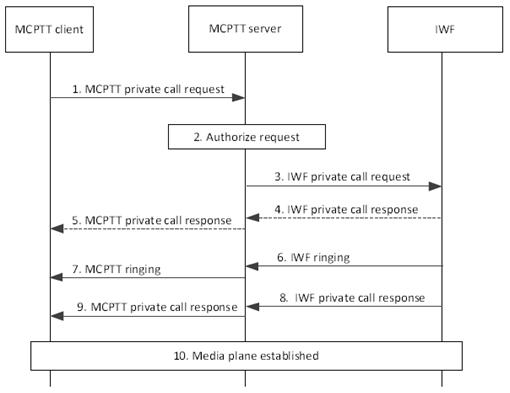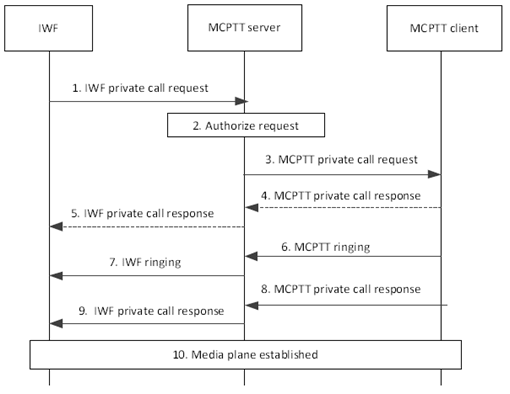Content for TS 23.283 Word version: 18.1.0
1…
10…
10.2…
10.2.2…
10.2.3…
10.3…
10.3.3…
10.3.3.7…
10.3.4…
10.3.4.4…
10.3.5…
10.3.5.8…
10.3.6…
10.3.7…
10.3.7.5…
10.3.8…
10.4…
10.4.4…
10.5…
10.5.7…
10.6…
10.6.2…
10.6.2.3…
10.6.3…
10.6.4…
10.7…
10.8…
10.11…
10.11.4…
10.12…
10.14…
10.15…
10.4 Private call
10.4.1 Information flows for private calls
10.4.1.1 General
10.4.1.2 IWF private call request
10.4.1.3 IWF private call response
10.4.1.4 IWF ringing
10.4.1.5 IWF call end request
10.4.1.6 IWF call end response
10.4.2 Private call setup in automatic commencement mode
10.4.2.1 MCPTT user initiating an MCPTT private call
10.4.2.2 LMR user initiating a private call with MCPTT user
10.4.3 Private call setup in manual commencement mode
10.4.3.1 MCPTT user is initiating an MCPTT private call
10.4.3.2 LMR user initiating a private call with MCPTT user
...
...
10.4 Private call p. 89
10.4.1 Information flows for private calls p. 89
10.4.1.1 General p. 89
The following subclauses define information flows for private calls on the IWF-1 interface. Private call related information flows on reference points other than IWF-1 are defined in TS 23.379.
10.4.1.2 IWF private call request p. 90
Table 10.4.1.2-1 describes the information flow IWF private call request from the MCPTT server to the IWF and from the IWF to the MCPTT server.
| Information element | Status | Description |
|---|---|---|
| MCPTT ID | M | The MCPTT ID of the calling party |
| Functional alias | O | The functional alias associated with the MCPTT ID of the calling party. |
| MCPTT ID | M | The MCPTT ID of the called party |
| Use floor control indication | M | This element indicates whether floor control will be used for the private call. |
| SDP offer | M | Media parameters of MCPTT client. |
| Encryption Algorithm | O | Encryption algorithm to use for the call. The field can also indicate whether the encryption algorithm choice is determined from information in the media stream. |
| Encryption mode | M | Whether E2EE will be used. |
| Requested commencement mode | O | An indication of the commencement mode to be used. |
| Implicit floor request
(see NOTE) | O | An indication that the user is also requesting the floor. |
| Location | O | Location of the calling party |
|
NOTE 1:
This element shall be included only when the originating client requests the floor.
|
||
10.4.1.3 IWF private call response p. 90
Table 10.4.1.3-1 describes the information flow IWF private call response from the MCPTT server to the IWF and from the IWF to the MCPTT server.
| Information element | Status | Description |
|---|---|---|
| MCPTT ID | M | The MCPTT ID of the calling party |
| MCPTT ID | O | The MCPTT ID of the called party |
| Acceptance confirmation | O | An indication whether the user has positively accepted the call. |
| SDP answer | M | Media parameters selected |
| Result | M | Result of the IWF private call request: success or failure |
| Encryption Algorithm(s) response | O | A list of one or more alternative encryption algorithm(s) to use for the call. |
| Use floor control indication response | O | This element indicates whether the floor control indication in the request is acceptable. |
| Implicit floor request response | O | This element indicates whether the indication that the user is also requesting the floor in the request is acceptable. |
10.4.1.4 IWF ringing p. 91
Table 10.4.1.4-1 describes the information flow IWF ringing from the MCPTT server to the IWF and from the IWF to the MCPTT server.
| Information element | Status | Description |
|---|---|---|
| MCPTT ID | M | The MCPTT ID of the calling party |
| MCPTT ID | M | The MCPTT ID of the called party |
| Ringing indication | O | Indication to the caller. |
10.4.1.5 IWF call end request p. 91
Table 10.4.1.5-1 describes the information flow IWF call end request from the MCPTT server to the IWF and from the IWF to the MCPTT server.
| Information element | Status | Description |
|---|---|---|
| MCPTT ID | M | The MCPTT ID of the calling party |
| MCPTT ID | M | The MCPTT ID of the called party |
10.4.1.6 IWF call end response p. 91
Table 10.4.1.6-1 describes the information flow IWF call end response from the IWF to the MCPTT server.
| Information element | Status | Description |
|---|---|---|
| MCPTT ID | M | The MCPTT ID of the responding party |
10.4.2 Private call setup in automatic commencement mode p. 91
10.4.2.1 MCPTT user initiating an MCPTT private call p. 91
In this procedure, an MCPTT user is initiating an MCPTT private call (automatic commencement mode) for communicating with a user in an LMR system, with or without floor control enabled.
This subclause is based on the procedure for private call setup in automatic commencement mode - MCPTT users in multiple MCPTT systems described in subclause 10.7.2.3.1 of TS 23.379.
In Figure 10.4.2.1-1, an MCPTT client initiates establishment of an MCPTT private call with an LMR user.
Pre-conditions:
- The calling MCPTT user has selected automatic commencement mode for the call;
- The MCPTT client is registered to the MCPTT service, as per procedure in subclause 10.2 in TS 23.379.
- Optionally, MCPTT client may use an activated functional alias for the call.
- The MCPTT server has subscribed to the MCPTT functional alias controlling server within the MC system for functional alias activation/de-activation updates.

Figure 10.4.2.1-1: Private call setup in automatic commencement mode, initiated by an MCPTT user
(⇒ copy of original 3GPP image)
(⇒ copy of original 3GPP image)
Step 1.
The MCPTT user at the MCPTT client initiates an MCPTT private call. The MCPTT client sends an MCPTT private call request towards the MCPTT server. The MCPTT private call request contains the MCPTT IDs corresponding to the calling MCPTT party and called LMR party and an SDP offer containing one or more media types. If available, the MCPTT user at the MCPTT client may also include a functional alias. The following parameters are also included that describe the MCPTT client's choices:
Step 2.
- the encryption algorithm;
- the encryption mode (encrypted or not);
- an indication of whether the MCPTT client is requesting the floor, and if the MCPTT client is requesting the floor, location information of the calling MCPTT client may be provided;
- requested commencement mode (automatic in this case); and
- an indication of whether the call is to be full or half duplex (whether to establish floor control).
The MCPTT server checks whether the MCPTT user at the MCPTT client is authorized to initiate the private call and whether the provided functional alias, if present, can be used and has been activated for the user. Because the IWF private call request is requesting automatic commencement mode, the MCPTT server also checks whether the MCPTT user at the MCPTT client is authorized to initiate a call in automatic commencement mode. If location information was included in the MCPTT private call request, the MCPTT server also checks the privacy policy (authorisation to provide location information to other MCPTT users on a call when talking, as defined in TS 23.379 Annex A.3) of the requesting MCPTT user to decide if the user's location information may be provided to other MCPTT users on the call and the IWF.
Step 3.
If authorized, the MCPTT server sends the IWF private call request that may or may not include location of the requestor, depending on the outcome of the privacy check towards the IWF, including the original parameters and offering the same media types or a subset of the media types contained in the initial received request as per TS 23.379.
Step 4.
The IWF sends an IWF private call response to the MCPTT server, indicating that the IWF does support one of the requested media types. The response indicates success or failure. If the indication is failure, the response may include one or more alternatives to the parameter values contained in step 3.
Step 5.
The MCPTT server forwards the MCPTT private call response to the MCPTT client. If the result parameter indicates success, then the MCPTT client proceeds to step 6. Otherwise, if the parameters returned in the MCPTT private call response are acceptable to the MCPTT client, then the MCPTT client can send a new MCPTT private call request with the new parameters and behaves according to those parameters. The calling MCPTT user may be notified of the change in parameters, for example, that the call is to be without floor control. The MCPTT user can choose to end the call rather than continue with the new parameters. If the parameters returned are not acceptable to the MCPTT client, then the call fails.
Step 6.
The MCPTT client has successfully established media plane for communication to the IWF and either end can transmit media. The MCPTT system initiating the call is responsible of granting the floor, solving competing floor requests and issuing floor revoked indications.
10.4.2.2 LMR user initiating a private call with MCPTT user p. 93
In this procedure, an LMR user is initiating a private call (in automatic commencement mode) for communicating with a user in MCPTT system, with or without floor control enabled.
This subclause is based on the procedure for private call setup in automatic commencement mode - MCPTT users in multiple MCPTT systems described in subclause 10.7.2.3.1 of TS 23.379.
In Figure 10.4.2.2-1, an LMR user initiates establishment of a private call with an MCPTT user.
Pre-conditions:
- The calling LMR user has selected automatic commencement mode for the call;
- The MCPTT client is registered to the MCPTT service, as per procedure in subclause 10.2 in TS 23.379.
- The LMR user at the LMR system has initiated a private call towards an MCPTT user.
- Optionally, LMR user may use an activated functional alias (homed in the MCPTT system) for the call.
- The MCPTT server has subscribed to the MCPTT functional alias controlling server within the MC system for functional alias activation/de-activation updates.

Figure 10.4.2.2-1: Private call setup in automatic commencement mode, initiated by an LMR user
(⇒ copy of original 3GPP image)
(⇒ copy of original 3GPP image)
Step 1.
The IWF sends an IWF private call request towards the MCPTT server. The IWF private call request contains the MCPTT IDs corresponding to the calling LMR party and the called MCPTT party and an SDP offer containing one or more media types. If available, the LMR party homed in the IWF may also include a functional alias. The following parameters are also included that describe the MCPTT client's choices:
Step 2.
- the encryption algorithm;
- the encryption mode (encrypted or not);
- an indication of whether the LMR user is requesting the floor, and if the MCPTT client is requesting the floor, location information of the calling MCPTT client may be provided;
- requested commencement mode (automatic in this case); and
- an indication of whether the call is to be full or half duplex (whether to establish floor control).
The MCPTT server checks whether the MCPTT user at the MCPTT client is authorized and able to receive the private call. Because the IWF private call request is requesting automatic commencement mode, the MCPTT server also checks whether the MCPTT user at the MCPTT client is authorized to receive a call in automatic commencement mode. The MCPTT server also checks whether the provided functional alias, if present, can be used and has been activated for the LMR user homed in the IWF.
Step 3.
If authorized, the MCPTT server sends the MCPTT private call request towards the MCPTT client, including the original parameters with or without the location of the calling party and offering the same media types or a subset of the media types contained in the initial received request as per TS 23.379.
Step 4.
The MCPTT client sends an MCPTT private call response to the MCPTT server indicating that the MCPTT client does support one of the requested media types. The response indicates success or failure. If the indication is failure, the response may also include one or more alternatives to the parameter values contained in step 3.
Step 5.
The MCPTT server sends the IWF private call response to the IWF offering the same media type as that sent in step 4. If the parameters returned are not acceptable to the IWF, then the call fails. If the parameters returned in the IWF private call response are different but acceptable to the IWF, then the IWF can send a new IWF private call request with the new parameters starting with step 1, which is to essentially restart the call. If there is no change of parameter, then the call proceeds to step 6.
Step 6.
The MCPTT client has successfully established media plane for communication to the IWF and either end can transmit media. The LMR system initiating the call is responsible of granting the floor, solving competing floor requests and issuing floor revoked indications.
10.4.3 Private call setup in manual commencement mode p. 94
10.4.3.1 MCPTT user is initiating an MCPTT private call p. 94
In this procedure, an MCPTT user is initiating an MCPTT private call (manual commencement mode) for communicating with an LMR user via an IWF, with or without floor control enabled.
This subclause is based on the procedure for private call setup in manual commencement mode - MCPTT users in multiple MCPTT systems described in subclause 10.7.2.3.2 of TS 23.379.
In Figure 10.4.3.1-1, an MCPTT client initiates establishment of an MCPTT private call with an LMR user.
Pre-conditions:
- The calling MCPTT user has selected manual commencement mode for the call.
- The MCPTT client is registered to the MCPTT service, as per procedure in subclause 10.2 in TS 23.379.
- Optionally, MCPTT client may use an activated functional alias (homed in the MCPTT system) for the call.
- The MCPTT server has subscribed to the MCPTT functional alias controlling server within the MC system for functional alias activation/de-activation updates.

Figure 10.4.3.1-1: Private call setup in manual commencement mode - initiated by an MCPTT user
(⇒ copy of original 3GPP image)
(⇒ copy of original 3GPP image)
Step 1.
The MCPTT user at the MCPTT client would like to initiate an MCPTT private call. The MCPTT client sends an MCPTT private call request towards the MCPTT server. The MCPTT private call request contains the MCPTT IDs corresponding to the calling MCPTT party and called LMR party and an SDP offer containing one or more media types. If available, the MCPTT user at the MCPTT client may also include a functional alias. The following parameters are also included that describe the MCPTT client's choices:
Step 2.
- the encryption algorithm;
- the encryption mode (encrypted or not)
- an indication of whether the MCPTT client is requesting the floor;
- requested commencement mode (manual in this case), and if the MCPTT client is requesting the floor, location information of the calling MCPTT client may be provided; and
- an indication of whether the call is to be full or half duplex (whether to establish floor control).
The MCPTT server checks whether the MCPTT user at the MCPTT client is authorized to initiate the private call and whether the provided functional alias, if present, can be used and has been activated for the user. Because the IWF private call request is requesting manual commencement mode, the MCPTT server also checks whether the MCPTT user at the MCPTT client is authorized to initiate a call in manual commencement mode. If location information was included in the MCPTT private call request, the MCPTT server also checks the privacy policy (authorisation to provide location information to other MCPTT users on a call when talking, as defined in TS 23.379 Annex A.3) of the requesting MCPTT user to decide if the user's location information may be provided to other MCPTT users on the call and the IWF.
Step 3.
If authorized, the MCPTT server sends the IWF private call request towards the IWF, including the original parameters that may or may not include location of the requestor, depending on the outcome of the privacy check, and offering the same media types or a subset of the media types contained in the initial received request as per TS 23.379.
Step 4.
The IWF may report failure with an IWF private call response to the MCPTT server. The response may include one or more alternatives to the parameter values contained in step 3. If the IWF does not report failure, the process proceeds with step 6.
Step 5.
The MCPTT server forwards the MCPTT private call response to the MCPTT client. If the result parameter indicates failure, the MCPTT client may abandon the call. If the parameters in the MCPTT private call response are acceptable to the MCPTT client, then the MCPTT client can send a new MCPTT private call request with the new parameters to the MCPTT server and behaves according to those parameters. The calling user may be notified of the change in parameters, for example, that the call is to be without floor control. The calling user may choose to end the call rather than continue with the new parameters.
Step 6.
The receiving IWF sends an IWF ringing to the MCPTT server while waiting for the call to be accepted.
Step 7.
The MCPTT server forwards the MCPTT ringing to the MCPTT client. The MCPTT client may indicate to the MCPTT user that the LMR user has been notified, e.g. by producing ringback audio.
Step 8.
Once the call has been accepted by the called user, the IWF sends an IWF private call response to the MCPTT server. The IWF private call response indicates that the IWF does support one of the requested media types.
Step 9.
The MCPTT server forwards the MCPTT private call response to the MCPTT client. The MCPTT client may indicate to the MCPTT user that the call is connected, e.g. by stopping the ringback audio.
Step 10.
The MCPTT client has successfully established media plane for communication to the IWF. The MCPTT system initiating the call is responsible of granting the floor and solving the competing floor requests, and floor revoked indications.
10.4.3.2 LMR user initiating a private call with MCPTT user p. 96
In this procedure, an LMR user is initiating a private call (in manual commencement mode) for communicating with an MCPTT user via an IWF, with or without floor control enabled.
This subclause is based on the procedure for private call setup in manual commencement mode - MCPTT users in multiple MCPTT systems described in subclause 10.7.2.3.2 of TS 23.379.
In Figure 10.4.3.2-1, an LMR user initiates establishment of a private call with an MCPTT user.
Pre-conditions:
- The calling LMR user has selected manual commencement mode for the call.
- The MCPTT client is registered to the MCPTT service, as per procedure in subclause 10.2 in TS 23.379.
- The LMR user at the LMR system has initiated a private call towards an MCPTT user.
- Optionally, LMR user may use an activated functional alias (homed in the MCPTT system) for the call.
- The MCPTT server has subscribed to the MCPTT functional alias controlling server within the MC system for functional alias activation/de-activation updates.

Figure 10.4.3.2-1: Private call setup in manual commencement mode, initiated by an LMR user
(⇒ copy of original 3GPP image)
(⇒ copy of original 3GPP image)
Step 1.
The IWF sends an IWF private call request towards the MCPTT server. The IWF private call request contains the MCPTT IDs corresponding to the calling LMR party and called MCPTT party and an SDP offer containing one or more media types. If available, the LMR party homed in the IWF may also include a functional alias. The following parameters are also included that describe the IWF's choices:
Step 2.
- the encryption algorithm;
- the encryption mode (encrypted or not)
- an indication of whether the LMR user is requesting the floor, and if the MCPTT client is requesting the floor, location information of the calling MCPTT client may be provided;
- requested commencement mode (manual in this case); and
- an indication of whether the call is to be full or half duplex (whether to establish floor control).
The MCPTT server checks whether the MCPTT user at the MCPTT client is authorized and able to receive the private call. Because the IWF private call request is requesting manual commencement mode, the MCPTT server also checks whether the MCPTT user at the MCPTT client is authorized to receive a call in manual commencement mode. The MCPTT server also checks whether the provided functional alias, if present, can be used and has been activated for the LMR user homed in the IWF.
Step 3.
If authorized, the MCPTT server sends the MCPTT private call request towards the MCPTT client, including the original parameters with or without the location of the calling party and offering the same media types or a subset of the media types contained in the initial received request as per TS 23.379.
Step 4.
The MCPTT client may report failure with an MCPTT private call response to the MCPTT server. The response may include one or more alternatives to the parameter values contained in step 3. If the MCPTT client does not report failure, the process proceeds with step 6.
Step 5.
The MCPTT server forwards the MCPTT private call response to the IWF. If the result parameter indicates failure, the IWF may abandon the call. If the parameters in the IWF private call response are acceptable to the IWF, then the IWF can send a new IWF private call request with the new parameters to the MCPTT server and behaves according to those parameters. The IWF may choose to end the call rather than continue with the new parameters.
Step 6.
The MCPTT client sends an MCPTT ringing to the MCPTT server while waiting for the call to be accepted by the MCPTT user.
Step 7.
The MCPTT server sends an IWF ringing to IWF the while waiting for the call to be accepted.
Step 8.
Once the call has been accepted by the called user, the MCPTT client sends an MCPTT private call response to the MCPTT server. The IWF private call response indicates that the IWF does support one of the requested media types.
Step 9.
The MCPTT sends the IWF private call response to the IWF.
Step 10.
The MCPTT client has successfully established media plane for communication to the IWF. The LMR system initiating the call is responsible of granting the floor, solving competing floor requests and issuing floor revoked indications.